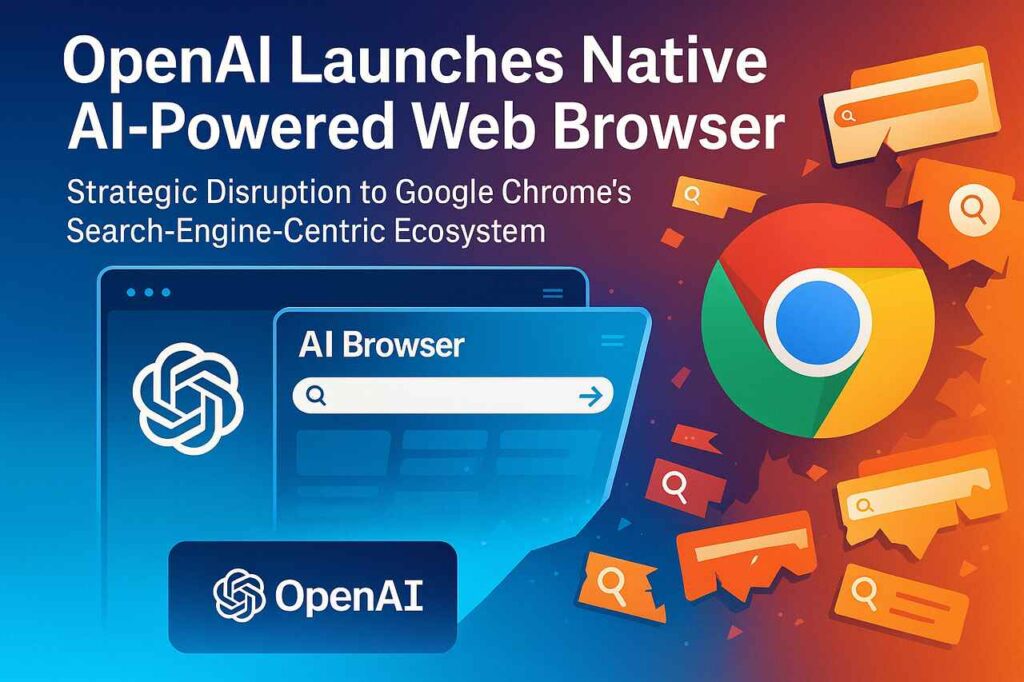Why Is OpenAI Entering the Web Browser Market?
OpenAI’s web browser represents a calculated move to vertically integrate AI capabilities into the web experience. Unlike traditional browsers, which rely heavily on static search engine protocols, OpenAI’s browser is designed to be a dynamic, real-time natural language interface that reduces user dependence on query-based search engines like Google Search.
What Strategic Gap Does OpenAI’s Browser Aim to Fill?
AI-native interaction replaces the reliance on keyword search syntax. Traditional browsers like Chrome act as passive gateways to search engines, while OpenAI’s browser transforms web browsing into an active information retrieval experience using language models and real-time semantic parsing.
How Will OpenAI’s Browser Affect Google Chrome’s Ecosystem?
Google Chrome’s ecosystem is built around integration with Google Search, Ads, and Gmail, reinforcing Google’s dominance in behavioral data harvesting and contextual ad targeting. An OpenAI browser shifts the center of gravity toward user-centric AI experiences, challenging Google’s ad revenue model by interposing AI intermediaries between users and search engines.
How Is OpenAI Leveraging ChatGPT in the Browser Experience?
ChatGPT’s integration enables contextual web summarization, queryless search, and in-browser autonomous agents. These functionalities provide proactive assistance, similar to AI copilots, allowing users to bypass traditional navigation flows and retrieve knowledge through task-based natural language prompts.
What Makes This Browser a Paradigm Shift in Search Behavior?
The browser introduces a zero-click search paradigm, where users receive direct answers without page redirection. Semantic understanding of intent, combined with ontological structuring of entities, allows the browser to synthesize data from multiple sources and deliver contextualized answers tailored to user objectives, not just keywords.
What Core Technologies Power the OpenAI Browser?
The foundation of OpenAI’s browser rests on multimodal large language models, contextual semantic indexing, and memory-enabled user interaction frameworks.
How Does Semantic Search Replace Traditional Index-Based Retrieval?
Semantic search evaluates user intent by mapping queries to concept graphs instead of relying on keyword frequency. Unlike Google’s inverted index method, OpenAI uses vector embeddings and retrieval-augmented generation (RAG) to understand the relationship between entities, events, and user goals in a given query.
How Do Memory and Personalization Affect Browsing?
Persistent memory modules allow the browser to retain user preferences, understand behavioral patterns, and refine recommendations over time. This transforms the browsing interface into a personal knowledge environment that learns and evolves with the user, increasing session continuity and relevance.
What Role Does Natural Language Processing Play?
NLP pipelines process and interpret user prompts into structured actions. Named Entity Recognition (NER), co-reference resolution, and topic modeling enable the browser to derive precise meanings from ambiguous inputs, creating high-accuracy interpretations without needing traditional dropdown menus or filters.
How Is Web Navigation Redefined Through AI Agents?
The browser employs autonomous web agents to execute tasks like form submissions, bookings, data scraping, and research compilation. These agents use goal-oriented task decomposition and web page affordance detection, interacting with elements via semantic understanding instead of manual clicks.
How Will This Move Impact Search Engine Optimization and Content Discovery?
AI browser interfaces will necessitate a shift from traditional SEO to Entity-Based and Intent-Focused Optimization.
Why Is Entity SEO Now More Critical Than Ever?
Entity SEO ensures that structured information about people, organizations, events, and products is machine-readable and retrievable by AI systems. As OpenAI’s browser bypasses keyword search, web content must now focus on semantic markup, schema.org integration, and knowledge graph alignment.
How Will Queryless Search Change Ranking Criteria?
Ranking becomes intent-weighted instead of keyword-density dependent. AI browsers prioritize semantic relevance, domain expertise, and discourse coherence, favoring articles that display clear entity-subentity relationships and goal-aligned content flows.
What Content Types Will Gain Visibility?
Content with rich ontological scaffolding, including FAQ sections, detailed how-to guides, and contextually grounded product reviews, will outperform general articles. AI systems favor modular knowledge chunks over long-form narratives that lack structured information pathways.
How Should Publishers Adapt to the New Search Architecture?
Publishers must integrate structured data markup, use natural language-friendly titles, and build entity-linking strategies that mirror the latent knowledge models used by language models. Dynamic content summarization and task-oriented UX flows will be vital for visibility in AI-driven browsers.
What Are the Long-Term Implications for the Search Ecosystem?
The OpenAI browser’s launch signals the beginning of an AI-dominant web interaction layer, potentially displacing traditional search engines as the central interface for online discovery.
Will This Reduce Dependence on Search Engines?
User reliance on traditional search engines will decline as AI-native browsers offer direct response models, reducing the need for users to manually sift through SERPs. The AI interface acts as both filter and processor, handling query refinement internally.
Can Google Adapt to This Disruption?
Google may evolve by infusing generative AI into Chrome and Search, but the structural dependence on its advertising-based business model could hinder rapid adaptation. OpenAI’s approach is native, not retrofitted, offering more fluid semantic integration.
What Happens to Web Traffic and Analytics?
Websites may see traffic changes as AI browsers deliver summarized content previews, lowering direct clicks but increasing brand exposure. Engagement metrics will shift from pageviews to user trust signals, semantic alignment, and intent satisfaction.
How Will This Affect Data Privacy and Control?
OpenAI’s memory-enabled systems raise new questions about data storage, personalization, and consent. Unlike cookie-based tracking, AI browsers operate on user-context modeling, which could offer better privacy-aware personalization if transparency and controls are implemented.
Stay ahead with breaking tech news, AI breakthroughs, and digital trends by exploring our full News & Technology insights library.

